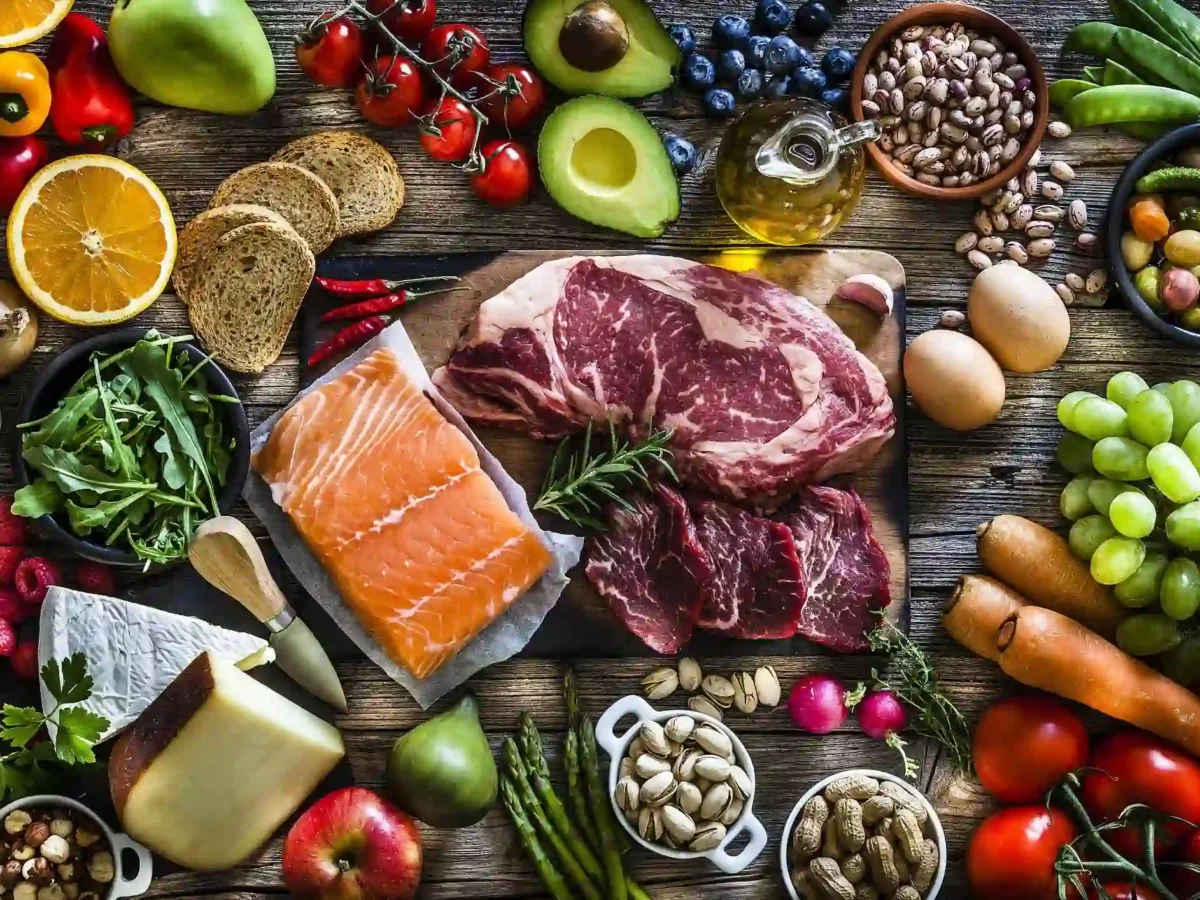Traveling can be a fantastic adventure, but it often comes with the challenge of eating healthy. With so many tempting local foods and quick snacks available, it’s easy to veer off your healthy eating path. This guide is all about helping you navigate the world of Healthy Food Travel, so you can enjoy your journeys while keeping your nutrition on track. We’ll cover practical tips on eating well, staying active, and making smart food choices while exploring new places.
Key Takeaways
- Pack nutritious snacks like nuts and dried fruits to avoid unhealthy options.
- Stay hydrated by carrying a refillable water bottle, especially in places where tap water isn’t safe.
- Research local eateries that focus on healthy options before you go.
- Incorporate physical activities into your travel plans, like walking tours or using hotel gyms.
- Be mindful of food safety, especially when trying street food; choose busy vendors with high turnover.
Eating Healthy on the Go
It can be tough to stick to healthy eating habits when you’re traveling. Airports, road trips, and new cities often mean limited options and lots of temptations. But with a little planning, it’s totally doable to maintain a balanced diet while you’re on the move. The key is to be prepared and make smart choices whenever possible.
Choosing Nutritious Snacks
Snacks can be your best friend or your worst enemy when traveling. Instead of hitting up the vending machine for chips and candy, pack your own healthy alternatives. Some great options include:
- Nuts and seeds: A handful of almonds, walnuts, or pumpkin seeds provides healthy fats, protein, and fiber.
- Dried fruit: Raisins, apricots, and cranberries are a good source of energy and antioxidants. Just watch the sugar content!
- Protein bars: Look for bars with low sugar and high protein to keep you feeling full and satisfied.
- Whole-grain crackers: Pair them with cheese or nut butter for a balanced snack.
Planning ahead is really important. I usually spend an hour before a trip prepping snacks. It saves me from making bad decisions when I’m starving and stuck in an airport.
Staying Hydrated While Traveling
Staying hydrated is super important, especially when you’re on the go. Dehydration can lead to fatigue, headaches, and even digestive issues. Carry a reusable water bottle and refill it whenever you can. Avoid sugary drinks like soda and juice, which can actually dehydrate you. If you’re flying, remember that the air on planes is very dry, so drink even more water than usual.
Balancing Indulgence with Health
Let’s be real, part of the fun of traveling is trying new foods! You shouldn’t deprive yourself of local delicacies, but it’s all about balance. Here’s how to enjoy the local cuisine without completely derailing your healthy eating habits:
- Practice mindful eating: Pay attention to your hunger cues and stop when you’re full.
- Choose wisely: Opt for grilled or baked options instead of fried foods.
- Share dishes: Restaurant portions are often huge, so split an entree with a friend.
- Don’t be afraid to ask: Ask your server about healthier options or modifications to dishes.
| Meal | Healthy Choice Example | Less Healthy Choice Example |
|---|---|---|
| Breakfast | Oatmeal with fruit and nuts | Pastry and sugary coffee |
| Lunch | Salad with grilled chicken | Burger and fries |
| Dinner | Grilled fish with vegetables | Pasta with cream sauce |
Packing Smart for Healthy Food Travel

Packing your own food for travel can be a game-changer for staying healthy and saving money. It’s all about being prepared and making smart choices before you even leave home. Let’s get into how to do it right.
Essential Foods to Bring
When it comes to packing food, think about items that are nutrient-dense and easy to transport. Prioritize foods that offer a good balance of protein, fiber, and healthy fats. Here are a few ideas:
- Nuts and Seeds: Almonds, walnuts, pumpkin seeds, and sunflower seeds are great sources of healthy fats and protein. They’re also easy to pack and don’t require refrigeration.
- Dried Fruit: Apricots, cranberries, and raisins can satisfy your sweet tooth while providing fiber and vitamins. Just watch the added sugar content.
- Protein bars: A quick and easy way to get a protein boost. Look for bars with low sugar and high fiber. Consider buying a protein boost before you leave.
- Whole-grain crackers: Pair them with nut butter or avocado for a filling snack.
Tips for Non-Perishable Options
Non-perishable foods are your best friend when traveling. Here’s how to make the most of them:
- Choose airtight packaging: This helps prevent spoilage and keeps your food fresh for longer.
- Consider freeze-dried meals: These are lightweight and require only hot water to prepare. They’re great for camping or hiking trips.
- Opt for single-serving packets: Individual packets of nut butter, oatmeal, or protein powder are convenient and help with portion control.
- Check expiration dates: Make sure your food won’t expire during your trip.
Packing your own food allows you to control what you eat, especially when you have dietary restrictions or preferences. It also reduces the temptation to grab unhealthy snacks at airports or rest stops.
Meal Prep Ideas for Travelers
Meal prepping isn’t just for home; it can be a lifesaver on the road. Here are some simple meal prep ideas:
- Overnight Oats: Combine rolled oats, chia seeds, milk (dairy or non-dairy), and your favorite toppings in a jar. Let it sit overnight in the fridge (if you have access to one) or pack it with an ice pack for a few hours.
- Homemade Trail Mix: Combine nuts, seeds, dried fruit, and a few dark chocolate chips for a customizable snack. Experiment with different combinations to keep things interesting.
- DIY Energy Bites: Mix oats, nut butter, honey, and protein powder. Roll into bite-sized balls and store in a container. These are perfect for a quick energy boost.
- Pre-cut Veggies and Hummus: Chop up carrots, celery, and bell peppers and pack them with individual hummus containers for a healthy and refreshing snack.
Exploring Local Cuisines Mindfully
Finding Healthy Restaurants
Okay, so you’re traveling and want to eat well. Finding healthy restaurants doesn’t have to be a chore. Start by doing a little research before you even leave. Apps and websites are your friends here. Look for places that highlight fresh, local ingredients. Don’t be afraid to check out reviews; sometimes other travelers will point you to hidden gems with healthier options. When in doubt, ask your hotel concierge or even locals for recommendations. They often know the best spots that aren’t overrun with tourists.
Understanding Local Ingredients
One of the coolest parts about traveling is trying new foods. But how do you make smart choices? Start by learning a bit about the local ingredients. What fruits and vegetables are in season? What are the regional specialties? Farmers’ markets are awesome for this. You can see what’s fresh and often chat with the vendors about how they use different ingredients. Plus, understanding what goes into your food can help you appreciate the culture even more.
Making Informed Choices
Okay, you’re at a restaurant, staring at a menu you barely understand. What now? First, don’t be afraid to ask questions. Seriously, servers are usually happy to explain dishes. Look for words like “grilled,” “steamed,” or “baked” instead of “fried” or “breaded.” Pay attention to portion sizes, too. Sometimes, ordering an appetizer as your main course is a good move. And remember, it’s okay to indulge a little! Just try to balance it out with healthier choices throughout the day. Practicing mindful habits can really help here.
It’s all about balance. You’re on vacation, so enjoy yourself! But making small, informed choices can help you stay healthy and feel good while you’re exploring new places.
Staying Active During Your Travels
It can be tough to keep up with your fitness when you’re traveling, but it’s super important for staying energized and feeling good. Finding ways to incorporate physical activity into your trip doesn’t have to be a chore; it can actually enhance your experience. Think of it as an opportunity to explore your destination in a more active and engaging way.
Incorporating Exercise into Your Itinerary
Planning is key! Before you even leave, look into fitness options at your destination. Does your hotel have a gym? Are there local parks or trails nearby? Even a little bit of research can help you make the most of your time. Consider booking accommodations with a gym or pool. Pack lightweight exercise gear and download fitness apps for workouts on the go.
Here are some ideas:
- Schedule active excursions like hiking or biking tours.
- Use travel days to move – stretch in the airport or walk around before a long flight.
- Try local fitness trends – join a beach yoga class or go for a jog along the Seine.
Exploring Destinations on Foot
One of the best ways to see a new place and stay active is simply to walk! Skip the taxis and buses whenever possible and explore on foot. You’ll discover hidden gems you might otherwise miss, and you’ll get a good workout in the process. Walking tours are a great option, too, offering a structured way to see the sights while getting your steps in.
Walking is not only a great way to stay active but also a fantastic way to immerse yourself in the local culture. You’ll notice details you’d miss from a car or bus, and you’ll have more opportunities to interact with locals.
Utilizing Hotel Gyms and Facilities
Many hotels now have pretty decent gyms, so take advantage of them! Even a quick 30-minute workout can make a big difference. If your hotel has a pool, swimming is a fantastic full-body workout. If the gym is not your thing, see if the hotel offers any fitness classes, like yoga or Pilates. Don’t forget to pack a resistance band for strength training anywhere.
Navigating Food Safety Abroad
Understanding Food Safety Standards
When you’re traveling, it’s easy to get caught up in the excitement and forget about basic food safety. Different countries have different standards, and what’s considered safe in one place might not be in another. It’s a good idea to do a little research before you go. Look into the local food safety regulations and common foodborne illnesses in the area. This can help you make informed decisions about where and what to eat. For example, some countries have strict rules about pasteurization, while others don’t. Knowing this can help you avoid potential health risks.
Avoiding Foodborne Illness
Nobody wants to spend their vacation sick in bed. Foodborne illnesses are a real risk when traveling, but there are things you can do to minimize your chances of getting sick.
Here are a few tips:
- Wash your hands often, especially before eating.
- Make sure food is cooked thoroughly.
- Avoid raw or undercooked meats and seafood.
- Be careful with dairy products, especially if they’re unpasteurized.
It’s also a good idea to avoid ice in your drinks, as it may be made with tap water. If you’re unsure about the water quality, stick to bottled water or other sealed beverages.
Tips for Eating Street Food Safely
Street food is a big part of the travel experience for many people. It can be a great way to try local specialties and experience the culture. However, it can also be risky if you’re not careful. Look for stalls that are busy and have a high turnover. This usually means the food is fresh and the vendors are following good hygiene practices. Make sure the food is cooked in front of you and served hot. Avoid stalls that look dirty or have food sitting out for a long time. Don’t be afraid to ask questions about the ingredients and how the food is prepared. If something doesn’t seem right, trust your gut and move on. Trusting your instincts can save you from a lot of trouble.
Maintaining a Balanced Diet on the Road
It’s easy to let your healthy habits slide when you’re traveling. New foods, different schedules, and the simple fact that you’re out of your routine can all throw you off. But with a little planning, it’s totally possible to maintain a balanced diet while you’re on the road. The key is to be mindful and make informed choices.
Creating a Travel Meal Plan
Planning your meals ahead of time might sound like a chore, but it can make a huge difference. Think about what you’ll be eating for breakfast, lunch, and dinner each day. This doesn’t mean you have to stick to a rigid schedule, but having a general idea will help you avoid making impulsive, unhealthy choices. Consider these points when planning:
- Research restaurants in advance: Look for places with healthy options or menus that cater to your dietary needs.
- Pack your own snacks: This will help you avoid those tempting gas station treats. Healthy road trip snacks like nuts, seeds, and dried fruit are great options.
- Plan for leftovers: If you’re eating out, consider ordering a larger portion and saving some for later.
Adjusting to Different Cuisines
One of the best parts about traveling is trying new foods! But it’s important to be aware of how different cuisines can impact your diet. Some cultures use more oil, salt, or sugar than you’re used to. Here’s how to adjust:
- Ask about ingredients: Don’t be afraid to ask your server about how a dish is prepared or what ingredients are used.
- Choose wisely: Opt for grilled, baked, or steamed dishes over fried ones.
- Balance your plate: Make sure you’re getting plenty of fruits, vegetables, and lean protein.
Mindful Eating Practices
Mindful eating is all about paying attention to your food and how it makes you feel. It’s about savoring each bite and being present in the moment. This can be especially helpful when you’re traveling, as it can help you avoid overeating and make healthier choices. Here are some tips:
- Eat slowly: Put your fork down between bites and really savor the flavors.
- Pay attention to your hunger cues: Eat when you’re hungry and stop when you’re full.
- Avoid distractions: Turn off the TV and put away your phone while you’re eating.
By practicing mindful eating, you can develop a healthier relationship with food and make better choices, even when you’re surrounded by tempting treats. It’s about finding a balance that works for you and enjoying the experience of eating without guilt or regret. Remember, it’s okay to indulge sometimes, but it’s important to do so consciously and in moderation. Maintaining a balanced diet is key.
Health and Wellness Resources for Travelers

Apps for Healthy Eating
There are a ton of apps out there that can seriously help you stick to your healthy eating goals while you’re traveling. Think of them as your pocket-sized nutritionists! Some apps let you scan barcodes to see nutritional info, which is super handy when you’re in a foreign grocery store trying to figure out what’s what. Others help you find restaurants with healthy options nearby. MyFitnessPal and Lose It! are popular choices for tracking calories and macros, even when you’re on the go. Don’t forget apps like HappyCow if you’re looking for vegan or vegetarian spots. These tools can make a big difference in staying on track.
Finding Local Health Stores
Sometimes you just need to restock on your favorite healthy snacks or supplements while you’re traveling. That’s where local health stores come in! These stores can be goldmines for finding healthy alternatives to the usual tourist traps.* *Finding them might take a little digging, but it’s worth it. Here’s how:
- Google Maps is your friend: Search for “health food store” or “organic market” in your destination.
- Ask locals: Hotel staff or people at local cafes often know the best spots.
- Check online forums: Travel forums or expat groups can have recommendations.
Finding a local health store can be a great way to discover new and interesting products that you might not find at home. Plus, it’s a chance to support local businesses and get a feel for the local culture.
Connecting with Nutritionists Abroad
If you have specific dietary needs or health concerns, connecting with a nutritionist abroad could be a game-changer. It might sound like a lot, but it’s totally doable! Here’s why it’s helpful and how to do it:
- Personalized Advice: A local nutritionist can give you advice tailored to the local cuisine and ingredients.
- Language Barrier Help: They can help you navigate menus and food labels in a foreign language.
- Peace of Mind: Knowing you have a professional to turn to can ease anxiety about food choices.
To find one, try searching online directories of registered dietitians or nutritionists in your destination. You can also ask your doctor for a referral or check with international health organizations. Don’t forget to check out complementary health approaches to enhance your well-being while traveling.
Final Thoughts on Healthy Food Travel
Traveling can be a blast, but keeping your health in check while you’re out exploring is super important. It’s all about making smart choices and planning ahead. You don’t have to skip out on trying local foods, just balance it with some healthier options. Pack snacks, stay active, and drink plenty of water. Remember, a little prep goes a long way in making sure you feel good during your adventures. So, go out there, enjoy the sights, and savor the flavors, all while keeping your health in mind. Safe travels!
Frequently Asked Questions
What are some healthy snacks I can take while traveling?
Good snacks include nuts, granola bars, and fresh fruits. They are easy to carry and keep you energized.
How can I stay hydrated on my trips?
Always drink plenty of water. If you’re in a place where tap water isn’t safe, buy bottled water.
Is it okay to try local foods?
Yes, but remember to balance it with healthy choices. Enjoy local dishes in moderation.
What should I pack for healthy eating on the road?
Pack items like protein bars, nut butters, and dried fruits. These are nutritious and easy to carry.
How can I stay active while traveling?
Try to walk or bike around your destination. Many hotels also have gyms you can use.
What should I know about food safety when abroad?
Be careful with street food and choose busy stalls. Always wash your hands before eating.
Everything you need—flights, hotels, car rentals, bike rentals, taxis, and eSIMs for travelers—book it all with Voyage Magnets.





